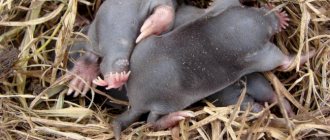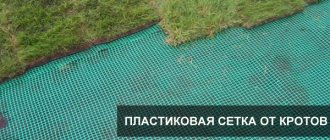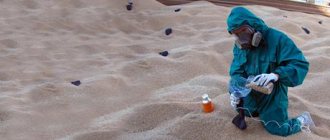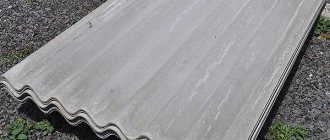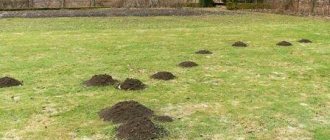The mole is a mammal from the order of insectivores, perfectly adapted to underground life. Thanks to the inverted front legs, which look like shovels, the animal easily digs the ground in front of itself, and the property of the hair fibers to grow straight allows the fur to easily lie both forward and backward.
This allows the animal to move through underground tunnels in different directions. In addition, the hairs on the mole's tail serve as a sense of touch, helping it walk tail first.
How deep is a mole hole? How and to what depth does a mole dig the ground?
Many people only know about the small animals living in the village from cartoons. We are talking about moles. Not many have seen them in the natural environment. And when they noticed it and examined it, they got scared. Their forelimbs look so bright. And, of course, not every person can tell how deep a mole’s hole is. For non-specialists, this interesting topic often remains a “closed secret.” But in fact it is quite educational. Not only biologists, but also people of other specialties study this topic in detail, keeping in mind its practical application. Let's not lag behind either. It might come in handy!
Construction method
Externally, a mole hole looks like small loosened tubercles of soil. The animal digs the ground with its front paws, which are shaped like a shovel and equipped with long, sharp claws. With the help of such equipment, the densest soil can be easily loosened.
The absence of large ears and a sharp muzzle make it easy to move underground, calmly get worms, and catch insects. With its hind legs, the animal throws the soil back and then transports it out. The places where the deep hole is located are marked from the outside by embankments.
In numerous labyrinths, other inhabitants of the underground world can settle; very often they become mice and earth rats. However, the mole does not give up without a fight and calmly drives the invaders out of his possessions.
Moles: benefits and harm
The common mole is of greatest economic importance. In the past, this animal was considered as an object of fur trade. Mole fur is beautiful and quite durable. It gained particular popularity at the end of the 19th and beginning of the 20th centuries, when the harvesting of skins was carried out on such a massive scale that the species began to need protection. Record figures were achieved in 1928, when 20 million skins were mined worldwide. In the USSR, mole hunting was carried out until the 1980s. Today in Russia they are not mined, which has become one of the reasons for the increase in their numbers. In addition, mild winters and improved conditions for its reproduction and nutrition, which include the spread of well-groomed lawns and flower beds, and an increase in the number of greenhouses for growing plants, favor the growth of common mole populations.
How to recognize molehills?
Not only a mole can dig the ground on a site. Similar activity is also typical for gophers, mole rats, and voles. Identifying the pest is important because it determines the strategy to combat it.
Moles dig tunnels under the surface of the earth. Such passages are called stern passages. Animals also dig another type of tunnel under the feeding tunnels, combining them into one network. It is because of them that characteristic piles are formed, reminiscent of mini-volcanoes.
The mole rat is larger than a mole; the piles of earth it digs up are almost half a meter in diameter, and it can weigh 10 kg. They form mounds and gophers, but their shape resembles a horseshoe. Voles also dig passages, but they do not leave heaps, but make visible passages under the surface or on it with a diameter of 5 cm.
Spade trap
When catching a mole, you need to wear thick gloves.
Although he has small, but very sharp teeth: after all, he is a predator. And with his claws he can easily tear your hand. - Having caught it, put it in a deep bucket and take it further into the forest - there it will destroy pests and will not cause serious harm, -
Nikolay Zhukov advises.
“If a mole falls into a trap, then it is most reasonable to take it out of the area directly in the mole trap, and at the place of release, open it and carefully shake the animal onto the ground.
It is better to release the mole among thick grass or in the forest, where it has a better chance of remaining unnoticed by predators. It is advisable to carry out the operation to free the prisoner immediately after his discovery: a few extra hours of hunger for him can become fatal. Leading a hidden lifestyle, the mole made practically no enemies. Very rarely does it become prey for a fox or raccoon dog. But even after catching it, they don’t eat it: it smells very bad. Many more moles die from the nimble little weasel, which is not deterred by the musky smell.
You need to understand that the effect of catching moles lasts only a week or two. Very quickly they resettle again. To ensure that you don’t let them into your plot (or at least your beds, greenhouses and flower beds), you need to dig a fine (up to 1 cm mesh) metal mesh, preferably galvanized, around the entire perimeter to a depth of about 50 cm. It should also protrude 15-20 cm above the soil surface. It will not interfere with the movement of worms and insects, but moles and most large rodents will not be allowed to enter the site. Instead of a mesh, you can use sheets of slate or roofing felt, folded in 2 - 3 layers. But then the worms won’t crawl through...
And further. If your neighbors also have moles, then everyone needs to drive them away (like cockroaches) at the same time. Otherwise, there will be an endless cycle of moles: some left, others came.
At one time, Zhukov visited a large metropolitan factory, proposing to launch the production of mole traps. But alas... This is not profitable for manufacturers. And hundreds of thousands of summer residents every year look for new ways to escape from garden diggers. According to Nikolai Vasilyevich, the most important thing in the fight against moles is patience. It is unlikely that you will be able to catch everyone the first time, but if you do this constantly, you will be pleased with the result.
It is estimated that 1 percent of agricultural production is lost due to moles. By making their tunnels underground, they damage the root system of plants.
In the old days, they used wormholes to determine what kind of winter it would be like. If a mole begins to dig a hole from the north side, then expect warmth, from the south - cold weather. Dig from the west - winter will be wet, and from the east - dry.
In the 20th century, not only fur coats were made from mole skins (up to 200 pieces were needed for each), but also masks to protect pilots’ faces from frostbite in cockpits that were not airtight at that time.
Source
At what depth do they live?
Still, let's figure out at what depth moles live. The depth of habitat at any time of the year remains almost unchanged - up to 50 cm. It makes no sense for the animal to dig deeper passages because it costs too much energy. After all, at great depths they are no longer able to raise the ceiling of the passage; they have to push the dug up soil with their hind legs to the surface. And the deeper you have to dig, the more problematic it becomes to carry out this titanic work. A deep hole occurs only in one case - when moles arrange a nesting chamber for sleep and rest.
What damage can moles cause to the garden?
The destruction of pests is a big plus for moles, but their gluttony is a minus. To dig well, you need to eat a lot and moles know this. On average, one individual eats as many pests per day as it weighs. Even rough estimates show that one animal is capable of clearing a vegetable garden of mole crickets, cockchafer larvae, and beetleworms in a couple of days.
But still, if a mole has settled in the ground, the damage will be colossal:
- he will dig up the entire garden and not leave a single free space;
- the animal will destroy the roots of trees, shrubs, and fruit crops;
- a mole is capable of undermining and collapsing greenhouse racks;
- Communications, pipelines and other life support systems will be in danger.
No matter how good the animal is, every gardener needs protection from moles.
DIY repellent devices
You can make a structure yourself that will protect your area from moles. To do this you will need:
- plastic bottle;
- metal rod;
- part of a water pipe.
It is easy to make such a device.
- Hammer the pipe into the ground so that its edge is below the level at which the passages were dug.
- Place the pin on top of the part of the pipe that is driven into the ground. Secure the pin with a plug.
- Make a hole in the bottom of the bottle with a hot nail. Its diameter must be larger than the diameter of the pin.
- On the surface of the bottle, make 4 U-shaped slits on different sides and bend the plastic. Place the structure on a pin secured in a piece of pipe.
Homemade repeller diagram
The wind will spin the bottle in a circle like a weather vane, and the empty pipe will generate resonance and spread it throughout the soil, including dug passages. Moles are afraid of such noises and leave the territory without having time to master it sufficiently so that later there is a desire to return back. On a plot of 6 acres, 2-3 such scarecrows will be enough. Based on this, you can calculate the quantity if your area is larger. For example, 30 acres will require 10 such structures. But their cheapness and ease of manufacture are justified.
Burrow length
People, considering the performance achieved by this small builder, focus on the depth of the structure. But there is a more interesting factor that may capture the imagination. Agree, many people can bury themselves four meters into the ground in a straight line. But building tunnels whose length is many times greater than your size is a huge job. So, this figure can reach up to three hundred and sixty meters (for a mole rat). And it is still unknown whether this is a record. The fact is that many species of moles have not been thoroughly studied. Science knows only general information about them. No one measured the length and depth of their holes. These include, for example, shrews. They are much smaller than moles. They can live unnoticed “under your nose” (in your garden). By the way, shrews are considered useful. They loosen the soil and eat pests.
Have you heard the blackbirds sing? I have no doubt they heard and enjoyed it. How do moles dig in your area? If fortune, by an unfortunate chance, turns its back on you, then the sensitive ear of the gardener will catch this “wonderful” sound. And then piles of excavated earth - mole hills - will disfigure your beloved lawn. And let them repeat that a mole on the plot is like a raven in the heights, like a crayfish in the water - an indicator of the purity of the environment, the most “kind” feeling experienced when seeing a mound in the middle of a cucumber bed is annoyance: why did they choose me?!
A cute animal from a Czech cartoon in real life ruins your mood in an instant. Pyramids of earth, erected overnight, and sometimes brazenly, right before our eyes, are the pinnacle of that beautiful city of trenches, tunnels and passages that each mole family digs. And if the soil in the field has dried up, which means the amount of food for moles has decreased, then expect guests to come to you, because you have fertilized the soil, it is fertile, fatty, and there are a lot of all kinds of larvae, worms, bugs and other food in it. By the way, moles do not hibernate, they only go deeper underground, where they wait out the winter in “preserves”: each one stores up to a kilogram of earthworms as live canned food. Such diligence requires serious work: by eating earthworms, larvae and insects, the mole digs up to 20 meters of underground passages in a garden or vegetable garden per day. It’s a shame that in addition to its beauty, the site also suffers biologically. Moles often dig tunnels directly under plants, causing their roots to hang in the air. Such a plant, cut off from nutrition, soon dies.
Humanity has come up with many ways to deal with the hardworking animal. The abundance of anti-mole methods suggests little effectiveness, but still, let’s not give up.
One of the radical methods is as follows. At the very beginning of spring, the perimeter of the area is surrounded underground (vertically) with a special plastic or galvanized mesh made of small cells. The mesh is buried to a depth of 1.2 meters with an exit of 30 centimeters to the outside. Digging to a shallower depth will not give any result. The mesh must be intact, without holes, otherwise the mole will find and certainly use them. The method is very labor-intensive. For example, if you take a plot of 6 acres, then the length of its perimeter will be approximately 100 meters. It will take a lot of effort and time to dig a hundred-meter trench.
An even more radical and inhumane method is killing with rat poison. Yes, he is capable of killing a mole. If the mole eats the poison. But how to get him to eat pickled grain? Craftsmen came up with the idea of using earthworms, cut into pieces and sprinkled with poison, as bait. The worms move for about 20 minutes - this is enough for the mole in the area to smell it, crawl and eat the treat. But I don’t even want to discuss such a knacker’s method, let alone resort to it.
You can get rid of moles, if there are only a few of them, in a simple and accessible way: a fresh mound is dug up right up to the opening in the tunnel, after which the wait begins for the mole to come “to do repairs.” All that remains is to deftly pick up the mole rat with a shovel and carry it over the fence to where far away.
An interesting trap with the philosophical name “Solomon’s trap” was invented by fighters against the mole regime. It looks like a cylinder 40 centimeters long, and the diameter is about the size of a mole hole. Made from galvanized iron or sheet metal. There are hanging doors at both ends of the pipe that only open inward. The Solomon's Trap is placed in a mole tunnel and covered with soil. Now all that remains is to wait for the mole to get into it.
To avoid setting useless traps in holes abandoned by moles, press down the mound with your foot, press down on the ground, and return to it after a couple of days. The Mole will restore this move if he uses it regularly. Set the trap there.
There are a lot of mole repellent units on sale. These are small devices that stick into the soil and produce sounds at low frequencies, extremely unpleasant for moles and inaudible for people. They need to be used correctly and applied not just one, but several pieces per site. If the size of your plot is more than six acres, install repellers in a checkerboard pattern at the operating distance of each (20-25 meters). The device needs to be rearranged from time to time. The mole can get used to the location of the signal point and learn to bypass it.
The method of killing animals using water is not very effective. The water hose is simply inserted into the hole. If there is water in the holes, the mole will not be able to live in them and will move to another place. But what he will choose - a neighboring plot, a field behind a fence, or a familiar place rich in worms 20 centimeters from a flooded hole - is difficult to predict. And the costs of fighting an uncertain outcome are too high. Firstly, you need a lot of water (at least 100-150 liters per mole) to flood all the passages. One bucket of water will only attract earthworms, which are their food, so instead you will only double the problem. Secondly, it is very difficult to completely fill all underground passages (air jams, etc.). And thirdly, moles dig very quickly (up to six meters per hour), so they can dig a passage above the water level and, after everything is absorbed, begin to make holes in your area again.
And finally, the old, ancient methods. They are still used today, which means they help someone:
- We plant plants in the area whose smell moles cannot stand: beans and black beans (the side shoots and tops of legumes can be placed directly in the tunnels). They can be planted in places or along the border of the site. Some flowers - daffodils, decorative onions, imperial hazel grouse and Siberian scilla, marigolds - are also not favored by moles and may scare them away.
- The mole has a very acute sense of touch and smell. With a generous hand, we place rotten fish, herring heads, rags soaked in kerosene, and naphthalene throughout the garden (including in holes). Just keep in mind that a mole can ruin this job, so you need to place the aromas in different points of the underground labyrinth.
- We put special bombs with sulfur smoke into the minks (you will just have to breathe, and the mole may go deeper for a while).
- The next repelling method is based on the fact that the mole has excellent hearing. (By the way, he also has vision, only his eyes are always covered with fur so that earth does not get into them.) So we will influence the hearing: we cut off reeds 1.5-2 meters long and insert one piece into each hole. The plant should protrude 60-80 centimeters above the ground surface. During windy weather, reeds create the effect of “the howling of the wind in a chimney,” which apparently frightens not only people, but also animals defenseless against mysticism. They say that moles disappear in almost a week. And they say they don't come back. Empty bottles stuck into holes at an angle of about 45 degrees work the same way.
- Personally, I used thin-walled aluminum beer cans and plastic bottles mounted on metal sticks. The principle is simple: a metal rod (a piece of reinforcement, a water pipe) is driven deep into the ground (1-1.5 meters), and an empty beer can is placed on it. The wind blows, the can rings and howls, the rod resonates, the sound and vibrations irritate the mole, and he runs away in panic to the neighbors.
But the most reliable remedy against moles, in my experience, is to get a dog. Our dachshund Gavrik so tirelessly and briskly stomps on the “ceiling” of the mole’s apartment that the unfortunate people do not consider such a life to be a life and avoid the area. Moreover, Gavrik has the patience to stand over a dug-up mound, waiting for the “repairman” mole. Of the three underground inhabitants, I saved (and expelled from the dacha village) two; the third, alas, fell victim to our big-eared hunter, who rejects a humane attitude towards our smaller brothers. But with the advent of the dog, and this is a fact, we forgot about the attack. The lawn is in perfect order. And now we are keeping blackbirds away from Gavrik.
A tireless worker in a luxurious velvet coat is forced to build tunnels in the ground every day. He needs a large amount of nutritious food that can support his vigorous activity.
Complex labyrinths underground
If you plot the underground passages of moles on paper, you will get a complex diagram of passages and labyrinths. The mole is an excellent digger. As soon as he enters a new area, his task is to find a secluded place to build a nest.
The choice will be given to a piece of land under a large tree, bush, something that will reliably protect from above. Expands the lair by compacting the earthen walls.
at what depth do moles and mole rats dig holes?
The nest has a convenient spherical shape and is located at a safe depth of about 1 meter underground.
The main tunnels diverge radially from the lair; they are wide and lie at a depth of 7 to 25 centimeters. The walls are tightly compacted so that they do not crumble during use and allow the mole to move quickly. These passages serve as tunnels for many years if the animal is not disturbed and driven away from the site.
Once the laying of the main “highways” is completed, the mole digs underground passages that connect them and lead to the main lair. This allows the mole to quickly leave the move in case of danger. At the end of the main passage, the mole makes several vertical exits to the surface of the earth. The end of the main passage is determined by the number of closely spaced molehills.
Scheme of mole labyrinths: 1 - nest, 2 - main passage, 3 - circular passages, 4 - vertical tunnels and molehills.
At what depth moles dig tunnels depends on their purpose. On the surface of the earth there are long ridges of loosened soil with frequent molehills. This is a move of the mole under a layer of soil no more than 3-5 cm , so as not to push the soil in front of itself, the animal throws the excess out. Close to the surface there is a lot of food, for which the mole “furrows” a piece of land.
Mole tunnels are located on several tiers, all connected to each other. The animal uses surface tunnels to search for food. Permanent highways serve for movement to feeding areas. The passages in them contain small depressions (chambers), which the mole uses for short-term rest. Depth up to 25 centimeters underground.
Let's look deeper
Nikolai Vasilyevich is confident that the fight against moles should begin in early spring, as soon as the snow melts and the first hills appear. But before you go hunting, you need to learn more about the pest itself and its habits. It is a small animal: 12 - 16 cm in length and up to 120 g in weight. It can live in any soil, with the exception of sandy soils - you cannot get worms in them. In soft and fertile soil, very often he does not throw the earth to the surface, but presses it into the walls of the passage. That is why it seems that there are no diggers on the site. The mole is ideally suited to life underground. The velvety, short, thick coat protects its skin from friction, allowing it to move forward and backward without difficulty. Wool, of course, wears out. But nature has also provided for this: the animals molt 3-4 times a year, acquiring a new coat each time.
The front feet are a kind of digging device with large, sharp and straight claws on the toes. And the mole’s hands are not directed downwards, like those of other animals, but to the sides - with the palms outward and backward.
The mole does not have ears, but this does not mean that he is deaf. His hearing is very well developed. As well as the sense of smell and touch, which perfectly help to find food. The eyes are small, blind (it’s still dark underground) and hidden in the fur. The teeth are sharply conical and similar in arrangement to crocodiles. The mole uses its tail, covered with stiff hairs, as a mechanical radar, using it to feel the walls and determine turns when running in “reverse gear.”
Animals spend most of their lives underground, only occasionally crawling to the surface from molehills. Contrary to popular belief that moles are nocturnal animals, they dig the ground almost around the clock with short rest breaks.
In search of food, they make more and more tunnels in the ground and build networks from them. And the more complex and confusing the tunnels, the more difficult it is to fight moles. Moves are usually of two levels. Forage, as a rule, is superficial, at a depth of 5 - 15 cm, in the fertile layer, where there is something to eat. Permanent passages are located at a depth of 20 - 35 cm or more. On average, a mole digs up to 20 m of new underground tunnels per day. And they all start from a wider main passage leading to the nesting chamber. Moles make nests at a depth of about 1.5 - 2 m, under trees, where the ground does not freeze and where the cold does not reach. In these warm and cozy burrows covered with leaves, moss and dry grass, they rest and breed.
Moles are very jealous of their territory and do not tolerate strangers. When meeting him, a fight is inevitable, with a fatal outcome for one of the animals.
As for the menu, for the most part it contains earthworms, caterpillars, beetle larvae (including May beetles) and other insects, as well as mice, lizards and frogs that got into the tunnel. By the way, the mole does not feed on roots. Making tunnels, he simply tears them with his powerful claws, exposing the roots, which causes the plants to dry out. Gnawed carrots, beets or potatoes are the work of the teeth of mice and mole crickets, which through mole labyrinths reach juicy vegetables.
A mole cannot live for long without food: if you catch it and don’t give it food for 10 to 12 hours, it will die. His metabolism is very rapid; he eats about one and a half times his own weight per day. Therefore, it is in an active search for food, constantly combing its feeding passages. If there is not enough food, it begins to actively build new tunnels. At one time, a mole eats up to 22 earthworms. Hence the large reserves: several hundred worms can be stored in a hole.
Moles are very prolific: they give birth twice a season and each litter contains 8 - 10 cubs. By the month they grow to adult size, becoming quarrelsome and pugnacious. Therefore, they leave their mother’s areas to occupy their own niches where there are no other moles. But they don’t go long distances. Adult moles, having settled in their burrows, control an area of no more than 1 hectare.
Asked about the migration of moles, Nikolai Vasilyevich once conducted an experiment by ringing three “diggers” and releasing them in Minsk near the Children’s Railway station. A month later I caught one. in the opposite corner of the botanical garden. During this time, the mole walked (if in a straight line) 970 m, but he dug his tunnel in zigzags...
Ecologists are sure that moles do not live on the territory of the dacha, but simply dig feeding passages there, coming for a new portion of food. Nikolai Vasilievich agrees with this:
— To catch a pest, you first need to find the starting point, the path along which the animal enters your area. Therefore, first of all, go around its perimeter and find permanent passages. There is no point in putting gear all over the territory. Mole traps will work more effectively in transition areas where the soil is dense and hard. You cannot place a trap in loose soil: the mole will either pick it up or bury it deeply.
To determine the current (that is, the most active) surface move, pay attention to the “snake” of the ground raised literally a couple of centimeters. Stomp it with your foot and mark it with something. If after 1 - 2 days the mole restores this move, it means that it is a worker, used several times a day. This is where traps should be installed.
Operating and active passages are most often straight and run along fences, paths, foundations and other restrictions. Sometimes the main path runs along fields or lawns surrounded by bushes and trees. Winding passages are a kind of “test” that the mole may never use again. And there is no point in setting traps here.
Nikolai Vasilyevich himself prefers two types of mole traps: wire and “crocodile”. But before buying, be sure to check both of them. If the wire is covered with scale, it is possible that it is overheated. Therefore, pay attention to the material itself and be sure to check the strength of the new wire trap by loading it in the store 2 - 3 times and releasing the pressure lever. The overheated one will simply burst.
If you level the mound, you will find a tunnel underneath it. The simplest wire mole traps should be placed in twos at once, with their rings pointing in different directions: it is unknown from which side the mole will return. But it will definitely return.
As for the “crocodiles,” they are installed one at a time along the passage, having first thoroughly cleaned it. If suddenly there is a pebble at the bottom, the trap will not work and will not slam shut. According to the instructions, the guard should be placed on the ledges, but Nikolai Vasilyevich always places it wider: and the moles are quite well-fed.
Star-nosed
Star-nosed mole The second name for the mole is star-nosed. It differs from its relatives by its unusual nose. The stigma consists of 22 soft processes - tentacles. Thanks to them, the animal gropes for food. The rest of the body structure is similar to the European mole.
- The mole's body is elongated, about 22 cm long.
- The tail is long - 8 cm.
- The coat is thick, soft, silky, black and brown in color.
- There are no auricles.
- Small eyes are not covered by skin.
The starfish swims and dives well. The mole feeds on crustaceans, slugs, earthworms, larvae, and mollusks. In addition to the underground, aquatic lifestyle, it leads a terrestrial one. It can build nests in rotten stumps, hollows of old trees, under leaves. Prefers swampy areas, soil with high humidity. Often found near rivers, lakes, and swamps in the United States.


